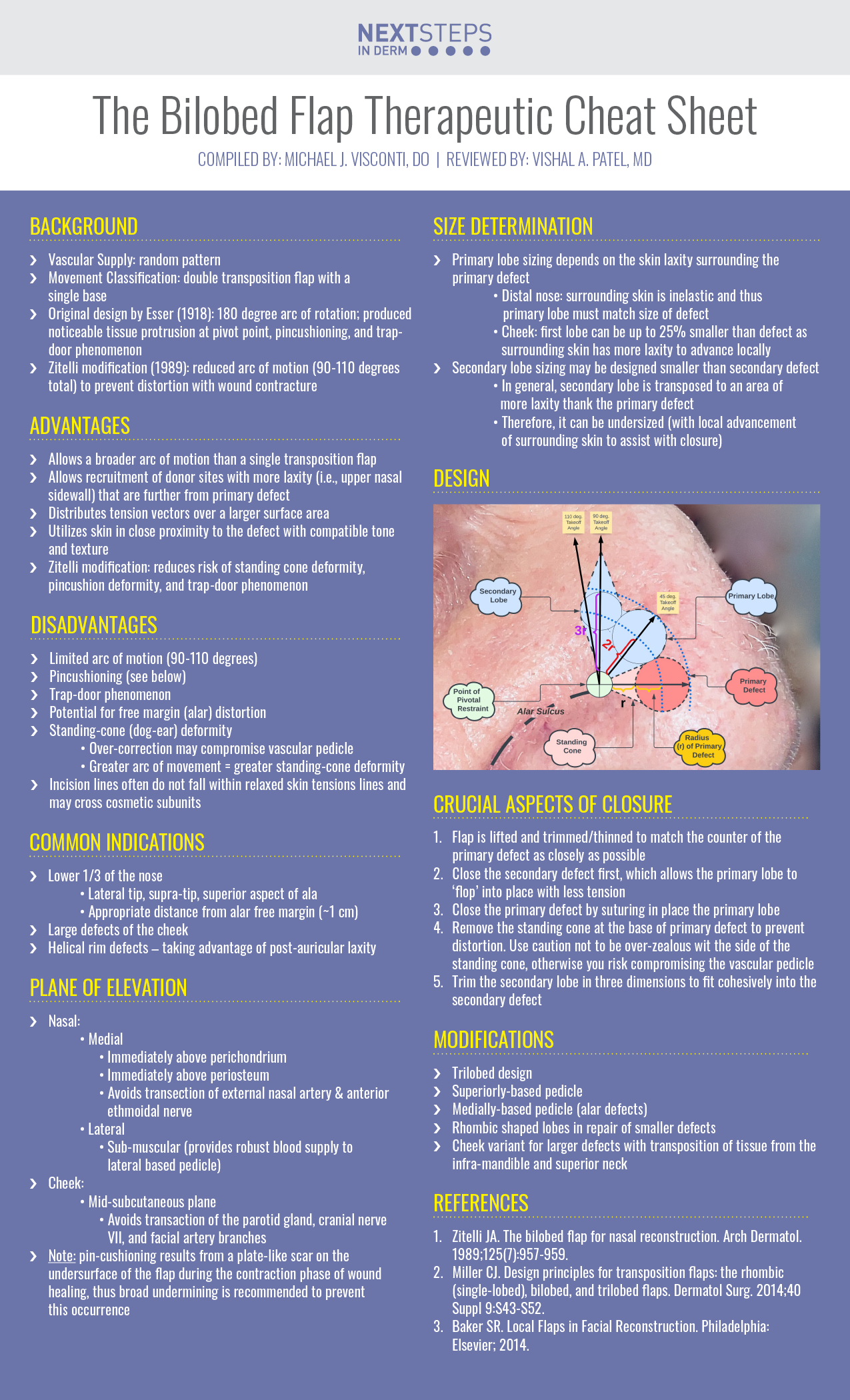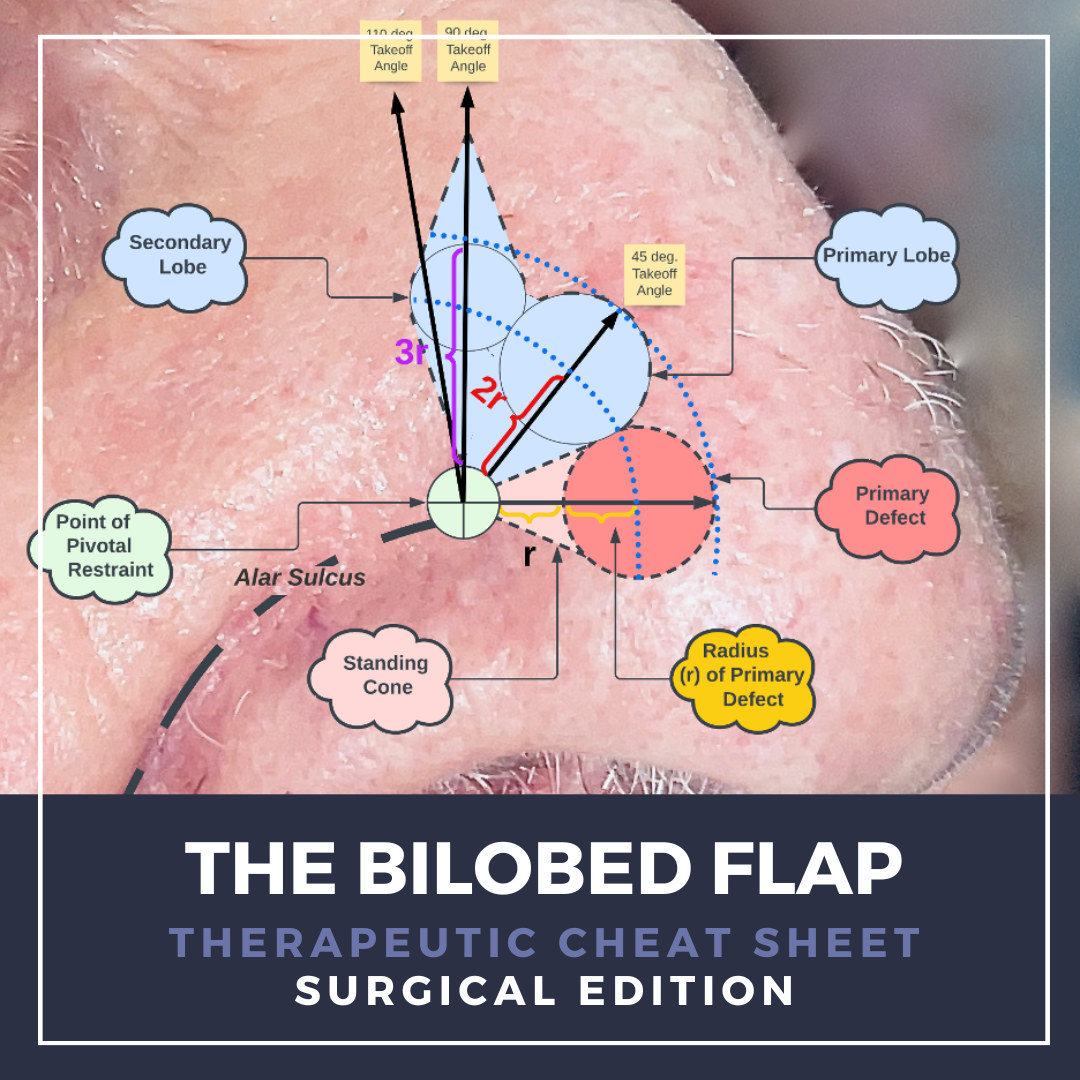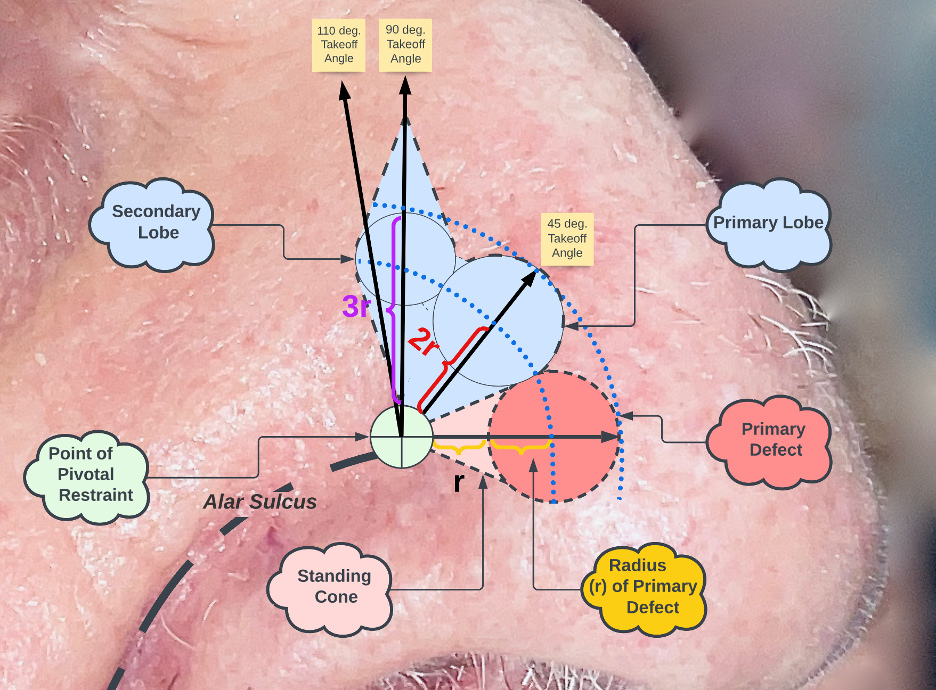Dr. Michael J. Visconti continues our Therapeutic Cheat Sheet series, surgical edition, with a look at the bilobed flap, one of the workhorse reconstructive designs in the armamentarium of dermatologic surgeons.
The Bilobed Flap Therapeutic Cheat Sheet
Compiled by: Michael J. Visconti, DO | Reviewed by: Vishal A. Patel, MD
Background
-
- Vascular Supply: random pattern
- Movement Classification: double transposition flap with a single base
- Original design by Esser (1918): 180 degree arc of rotation; produced noticeable tissue protrusion at pivot point, pincushioning, and trap-door phenomenon
- Zitelli modification (1989): reduced arc of motion (90-110 degrees total) to prevent distortion with wound contracture
Advantages
-
- Allows a broader arc of motion than a single transposition flap
- Allows recruitment of donor sites with more laxity (i.e., upper nasal sidewall) that are further from primary defect
- Distributes tension vectors over a larger surface area
- Utilizes skin in close proximity to the defect with compatible tone and texture
- Zitelli modification: reduces risk of standing cone deformity, pincushion deformity, and trap-door phenomenon
Disadvantages
-
- Limited arc of motion (90-110 degrees)
- Pincushioning (see below)
- Trap-door phenomenon
- Potential for free margin (alar) distortion
- Standing-cone (dog-ear) deformity
♦ Over-correction may compromise vascular pedicle
♦ Greater arc of movement = greater standing-cone deformity - Incision lines often do not fall within relaxed skin tensions lines and may cross cosmetic subunits
Common Indications
-
- Lower 1/3 of the nose
♦ Lateral tip, supra-tip, superior aspect of ala
♦ Appropriate distance from alar free margin (~1 cm) - Large defects of the cheek
- Helical rim defects – taking advantage of post-auricular laxity
- Lower 1/3 of the nose
Plane of Elevation
-
- Nasal:
♦ Medial- Immediately above perichondrium
- Immediately above periosteum
- Avoids transection of external nasal artery & anterior ethmoidal nerve
♦ Lateral- Sub-muscular (provides robust blood supply to lateral based pedicle)
- Cheek:
♦ Mid-subcutaneous plane- Avoids transaction of the parotid gland, cranial nerve VII, and facial artery branches
- Nasal:
Note: pin-cushioning results from a plate-like scar on the undersurface of the flap during the contraction phase of wound healing, thus broad undermining is recommended to prevent this occurrence
Size Determination
-
- Primary lobe sizing depends on the skin laxity surrounding the primary defect
♦ Distal nose: surrounding skin is inelastic and thus primary lobe must match size of defect
♦Cheek: first lobe can be up to 25% smaller than defect as surrounding skin has more laxity to advance locally
- Primary lobe sizing depends on the skin laxity surrounding the primary defect
-
- Secondary lobe sizing may be designed smaller than secondary defect
♦In general, secondary lobe is transposed to an area of more laxity thank the primary defect
♦Therefore, it can be undersized (with local advancement of surrounding skin to assist with closure)
- Secondary lobe sizing may be designed smaller than secondary defect
Design
Crucial Aspects of Closure
-
- Flap is lifted and trimmed/thinned to match the counter of the primary defect as closely as possible
- Close the secondary defect first, which allows the primary lobe to ‘flop’ into place with less tension
- Close the primary defect by suturing in place the primary lobe
- Remove the standing cone at the base of primary defect to prevent distortion. Use caution not to be over-zealous wit the side of the standing cone, otherwise you risk compromising the vascular pedicle
- Trim the secondary lobe in three dimensions to fit cohesively into the secondary defect
Modifications
-
- Trilobed design
- Superiorly-based pedicle
- Medially-based pedicle (alar defects)
- Rhombic shaped lobes in repair of smaller defects
- Cheek variant for larger defects with transposition of tissue from the infra-mandible and superior neck

References
1. Zitelli JA. The bilobed flap for nasal reconstruction. Arch Dermatol. 1989;125(7):957-959.
2. Miller CJ. Design principles for transposition flaps: the rhombic (single-lobed), bilobed, and trilobed flaps. Dermatol Surg. 2014;40 Suppl 9:S43-S52.
3. Baker SR. Local Flaps in Facial Reconstruction. Philadelphia: Elsevier; 2014.
Did you enjoy this Therapeutic Cheat Sheet? You can find more here.


